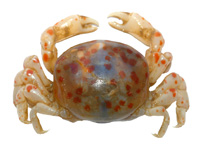Abstract
A new species of seahorse, Hippocampus casscsio sp. nov. was collected over shallow seagrass beds in Beibu Bay, China. This species is diagnosed from all other seahorse species by morphological characters, including the lower number of tail rings (35); 15 pectoral-fin rays; 16 dorsal-fin rays; a rounded nuchal plate without a raised coronet; a snout length 30% head length; two cheek spines and a dark brown coloration. In addition, molecular analysis showed all individuals of the new species clustering together suggesting a monophyletic lineage. This combined analysis supports the distinctness of H. casscsio sp. nov. as a new species, which is described herein.
References
Bartlett, S.E. & Davidson, W.S. (1991) Identification of Thunnus species by the polymerase chain reaction and direct sequence analysis of their mitochondrial cytochrome b genes. Canadian Journal of Fisheries and Aquatic Sciences, 48, 309–317.
http://dx.doi.org/10.1139/f91-043Dawson, C.E. (1985) Indo-Pacific Pipefishes (Red Sea to the Americas). The Gulf Coast Research Laboratory, Mississippi, 230 pp.
Gutiérrez, M.A.C., Vivero, R.J., Vélez, I.D., Porter, C.H. & Uribe, S. (2014) DNA Barcoding for the Identification of Sand Fly Species (Diptera, Psychodidae, Phlebotominae) in Colombia. PloS ONE, 9, e85496.
http://dx.doi.org/10.1371/journal.pone.0085496Hall, T.A. (1999) BioEdit: a user-friendly biological sequence alignment editor and analysis program for Windows 95/98/NT. In: Nucleic Acids Symposium Series, pp. 95–98.
Horne, M.L. (2001) A new seahorse species (Syngnathidae: Hippocampus) from the Great Barrier Reef. Records-Australian Museum, 53, 243–246.
http://dx.doi.org/10.3853/j.0067-1975.53.2001.1330Keckler, D. (1997) SURFER for Windows: version 6 user's guide: contouring and 3D surface mapping: Golden Software Incorporated, 5 pp.
Kimura, M. (1980) A simple method for estimating evolutionary rates of base substitutions through comparative studies of nucleotide sequences. Journal of Molecular Evolution, 16, 111–120.
http://dx.doi.org/10.1007/BF01731581Koldewey, H.J. & Martin-Smith, K.M. (2010) A global review of seahorse aquaculture. Aquaculture, 302, 131–152.
http://dx.doi.org/10.1016/j.aquaculture.2009.11.010Larkin, M., Blackshields, G., Brown, N., Chenna, R., McGettigan, P., McWilliam, H., Valentin, F., Wallace, I.M., Wilm, A., Lopez, R., Thompson, J.D., Gibson, T.J. & Higgins, D.G. (2007) Clustal W and Clustal X version 2.0. Bioinformatics, 23, 2947–2948.
http://dx.doi.org/10.1093/bioinformatics/btm404Librado, P. & Rozas, J. (2009) DnaSP v5: a software for comprehensive analysis of DNA polymorphism data. Bioinformatics, 25, 1451–1452.
http://dx.doi.org/10.1093/bioinformatics/btp187Lourie, S.A. (2003) Measuring seahorses. Project Seahorse Technical Report No.4, Version 1.0. Project Seahorse, Fisheries Centre, University of British Columbia. 15 pp.
Lourie, S.A., Green, D. & Vincent, A. (2005) Dispersal, habitat differences, and comparative phylogeography of Southeast Asian seahorses (Syngnathidae: Hippocampus). Molecular Ecology, 14, 1073–1094.
http://dx.doi.org/10.1111/j.1365-294X.2005.02464.xLourie, S.A. & Randall, J.E. (2003) A new pygmy seahorse, Hippocampus denise (Teleostei: Syngnathidae) from the Indo-Pacific. Zoological Studies, 42, 284–291.
Lourie, S.A., Pritchard, J.C., Casey, S.P., Truong, S.K., Hall, H.J. & Vincent, A.C. (1999) The taxonomy of Vietnam's exploited seahorses (family Syngnathidae). Biological Journal of the Linnean Society, 66, 231–256.
http://dx.doi.org/10.1111/j.1095-8312.1999.tb01886.xLourie, S.A., Pollom, R.A. & Foster, S.J. (2016) A global revision of the Seahorses Hippocampus Rafinesque 1810 (Actinopterygii: Syngnathiformes): Taxonomy and biogeography with recommendations for further research. Zootaxa, 4146 (1), 1–66.
http://dx.doi.org/10.11646/zootaxa.4146.1.1Lourie, S.A. & Vincent, A.C. (2004) A marine fish follows Wallace's Line: the phylogeography of the three-spot seahorse (Hippocampus trimaculatus, Syngnathidae, Teleostei) in Southeast Asia. Journal of Biogeography, 31, 1975–1985.
http://dx.doi.org/10.1111/j.1365-2699.2004.01153.xLourie, S.A., Vincent, A.C. & Hall, H.J. (1999) Seahorses: an identification guide to the world's species and their conservation. Project Seahorse. London, UK. 109 p, 114 p.
Masuda, H. & Muzik, K.M. (1984) The fishes of the Japanese Archipelago (Vol. 2),Tokai University Press Tokyo.
Powers, D.A. (1991) Evolutionary genetics of fish. Advances in Genetics, 29, 120–228.
http://dx.doi.org/10.1016/s0065-2660(08)60108-xTamura, K., Stecher, G., Peterson, D., Filipski, A. & Kumar, S. (2013) MEGA6: molecular evolutionary genetics analysis version 6.0. Molecular Biology and Evolution, 30, 2725–2729.
http://dx.doi.org/10.1093/molbev/mst197Teske, P., Cherry, M. & Matthee, C. (2003) Population genetics of the endangered Knysna seahorse, Hippocampus capensis. Molecular Ecology, 12, 1703–1715.
http://dx.doi.org/10.1046/j.1365-294X.2003.01852.xWilson, A.B., Vincent, A., Ahnesjö, I. & Meyer, A. (2001) Male pregnancy in seahorses and pipefishes (family Syngnathidae): rapid diversification of paternal brood pouch morphology inferred from a molecular phylogeny. Journal of Heredity, 92, 159–166.
http://dx.doi.org/10.1093/jhered/92.2.159Zhang, Y., Pham, N.K., Zhang, H., Lin, J. & Lin, Q. (2014) Genetic variations in two seahorse species (Hippocampus mohnikei and Hippocampus trimaculatus): evidence for Middle Pleistocene population expansion. PloS ONE, 9, e105494.
http://dx.doi.org/10.1371/journal.pone.0105494

